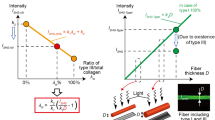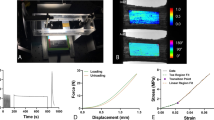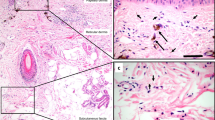Abstract
IN recent years several investigations1–3 have thrown doubt on the specificity of resorcin fuchsin as a reliable stain for structures containing the protein elastin. These investigations have also indicated that some alteration in the state of collagen may cause the latter to react with this stain. Partridge4 has suggested that this alteration is denaturation and the increase in reactivity which occurs with this change allows the protein to react with phenolic dyes. However, although resorcin fuchsin contains a phenol, the actual basic dyes used in the stain are not phenolic. Furthermore, it can be shown that certain fibres in connective tissue which stain with resorcin fuchsin but which are demonstrably different from the elastic tissue of the aorta, cannot be distinguished from normal collagen using the basic dyes from resorcin fuchsin without additives. Since denatured collagen has an isoelectric point of 4.8 compared with 7.5 (ref. 5) for the normal protein a simple basic dye should distinguish between the two. Such a result could not be obtained in the connective tissues mentioned. It follows, therefore, that connective tissue contains either three types of fibre reactive to resorcin fuchsin, namely, elastic tissue, denatured collagen and a previously undescribed fibre (Fig. 1), or some other aspect of collagen denaturation must be considered in accounting for the similarity in the staining reactions of elastic tissue and denatured collagen. It is the purpose of this communication to suggest that the loss of crystalline structure that occurs when collagen is denatured6 accounts for this similarity and disposes of the need to postulate any other resorcin positive fibre in connective tissue.
This is a preview of subscription content, access via your institution
Access options
Subscribe to this journal
Receive 51 print issues and online access
$199.00 per year
only $3.90 per issue
Buy this article
- Purchase on Springer Link
- Instant access to full article PDF
Prices may be subject to local taxes which are calculated during checkout
Similar content being viewed by others
References
Tunbridge, R. E., Tattersall, R. N., Hall, D. A., Astbury, W. T., and Reed, R., Clin. Sci., 11, 315 (1952).
Gillman, T., Penn, J., Bronks, D., and Roux, M., Nature, 174, 789 (1954); Gillman, T., et al., Arch. Path., 59, 733 (1955).
Loewi, G., Glynn, L. E., and Dorling, J., J. Path. Bact., 80, 1 (1960).
Partridge, S. M., Adv. Protein Chem., 17, 227 (1962).
Hall, D. A., The Chemistry of Connective Tissue (Thomas, Springfield, 1960).
Harrington, W. F., and Von Hippel, P. H., Adv. Protein Chem., 16, 1 (1961).
Wigglesworth, V. B., Quart. J. Micro. Sci., 93, 105 (1952).
Vickerstaff, T., The Physical Chemistry of Dyeing (Oliver and Boyd, London–Edinburgh, 1954).
Beal, W., Dickinson, K., and Bellhouse, E., J. Soc. Dyers and Colourists, 76, 333 (1960).
Bowes, J. H., and Kenten, R. H., Biochem. J., 43, 358 (1948).
Author information
Authors and Affiliations
Rights and permissions
About this article
Cite this article
NEWTON, A. Collagen, Elastic Tissue and Resorcin Fuchsin. Nature 209, 1146–1147 (1966). https://doi.org/10.1038/2091146a0
Issue Date:
DOI: https://doi.org/10.1038/2091146a0
Comments
By submitting a comment you agree to abide by our Terms and Community Guidelines. If you find something abusive or that does not comply with our terms or guidelines please flag it as inappropriate.



